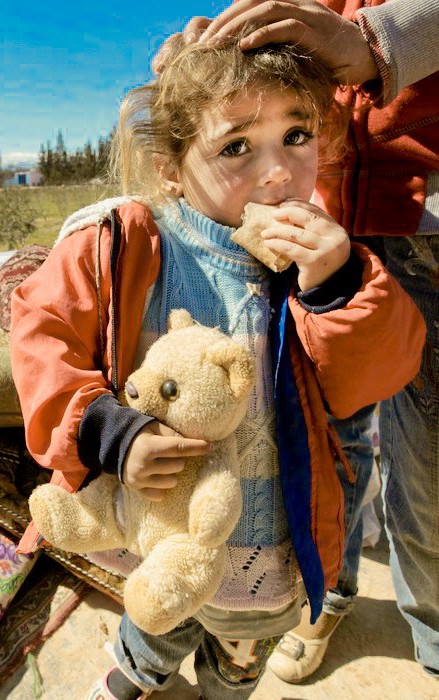By Raquel Prado
We are currently witnessing a massive influx into the EU of people fleeing from conflicts going on mainly in Syria, Afghanistan, Eritrea and Ukraine. This crisis is testing out the Common European Asylum System (CEAS) as a whole (if not putting it in a tight spot), and in particular the Directive 2001/55/EC of 20 July 2001 on minimum standards for giving temporary protection in the event of a mass influx of displaced persons and on measures promoting a balance of efforts between Member States in receiving such persons and bearing the consequences thereof. This standard has never been put into practice in its 14 years of existence – maybe because it was considered there was no need – until now, that is.
We might come to the conclusion that the reason for the directive not being implemented in the current humanitarian crisis is the lack of political will, concealed behind the trigger mechanism included in the Directive. Art. 5 states that in order for this rule to take effect, there will have to be a decision by the European Council, adopted by qualified majority on a proposal from the Commission. This has simply not been given, despite repeated recommendations from the European Parliament.
In the case of children, also the fact of arriving in large groups makes them a journalistic hot topic, but at the same time socially and legally invisible.
As Ineli-Ciger, researcher, points out, this standard would not solve the problem – but it would certainly help and provide a better framework for asylum seekers. Among the issues that it could resolve would be coordination and solidarity between Member States, which consumes so much paper these days, coupled with producing a joint response involving uniform solutions and, in the same vein, specific guidelines for all stakeholders involved in the reception of immigrants.
There are also refugees that the EU and its Member States have pledged to protect in any circumstances, and regardless of the political balance of the Union: children without parental care. The protection of these children does not require activation of this Directive, but it would certainly make it easier to implement.
As reported for years by the United Nations High Commissioner for Refugees (UNHCR), half of the forced migrants in the world are children. In the case of Syria, according to the UNHCR, chilren represent more than one million, eight hundred thousand of whom are under 11 years old. To these must be added the Afghans, Ukrainians, and all those who have been coming from Africa and other parts of the world for years.
Now is the time to see if, within this fortress Europe, anything of the humanitarian spirit of the twentieth century still remains; a spirit which led to the Convention on the Rights of the Child
Many children have lost their families, are alone, and need to find them or someone who can take responsibility for them. They are known today as Unaccompanied Child Migrants. These are children who have no adults to protect them, nor any State to return to – to the point that authors like Jacqueline Bhabha considers them stateless refugees.
This summer every news report has been totting up how many children were arriving in each boat in each group from each border, even how many were travelling without an adult. But the number of unaccompanied minors that may be on European soil right now is still unknown. In 2013 Eurostat recorded little more than 12,000 asylum applications by unaccompanied minors, on aggregate, in the whole of the EU. According to Human Rights Watch, in 2014 that figure was reached by Greece and Italy alone. In 2015 the increase is turning out to be exponential, thus giving us an idea of the implications of this new phase.
The EU Action Plan for Unaccompanied Minors was approved in 2010. This plan stipulates the scarce provisions applicable so far, and the guidelines for the reception of minors. The main measures proposed are the prevention of migration, protection in the host country, and long-lasting solutions, understood as return, resettlement or fostering. The European institutions could claim that a situation like the present one was not foreseen when the common policy on unaccompanied minors was originally drafted. However, there should be no lack of tools if we consider that at the community level all legislation that affects these children is included in the Common European Asylum System (CEAS) in the case of migrant minors, as in almost any issue related to international protection provided for under the UNHCR guidelines.
There are also refugees that the EU and its Member States have pledged to protect in any circumstances, and regardless of the political balance of the Union: children without parental.
The challenges these children pose far exceeds EU obligations as regards adults. These are the basic measures to consider: immediate protection by state authorities, where the age of the person is not in question; application of the ban on administrative detention, even though this is in fact being applied, mainly in the UK and Greece; access to basic welfare and education, which is not usually enforceable until a durable solution is formalised; the appointment of a guardian – a stipulation rarely met; and access to justice, which is not always guaranteed. The Dublin regulation III also exempts them from the requirement that their application be processed in the country of arrival, if any reason exists which recommends their staying, or transfer to another State. In spite of instruments such as the Communication of 2011 An EU agenda for the Rights of the Child, as so often happens in Europe, the EU does not have powers in the area of minors. This protection and these guarantees will therefor depend on the will of the Member States; even that of the (German) landers, autonomous communities and municipalities. Paradoxically, the child protection system in these highly regulated local authorities would make impracticable today any private initiative to help this group, whether completely private or broad-based.
That is why at this point we return to the much-needed implementation of Directive 2011/55/EC against the backdrop of the massive influx of refugees. This measure is vital for all asylum seekers. However, in the case of children, also the fact of arriving in large groups makes them a journalistic hot topic, but at the same time socially and legally invisible – and therefore increases the risk of kidnapping, trafficking, rape, slavery, malnutrition, and any other type of abuse. The drafting of a solid plan for temporary reception of refugees through existing mechanisms would enable, at least, identification of these minors – and their immediate protection. Coordination between States would distribute the weight of this responsibility, and in many cases reunite some of these children with their families, an impossible task under any other circumstances. An appeal for collaboration from the population, with the obvious filters to ensure the suitability of those who take in children, might be another solution, now long forgotten. The longer we delay, the more severe the consequences of Member States’ carelessness will be. And these children will spend more time stranded in makeshift camps, where they should not be, and where the trauma that will accompany them throughout their entire life could be made worse.
The time has come to test the complex refugee children protection system, and we face endless unknown quantities. Among these: what will happen in cases like Spain, which admits an average of ten asylum applications a year for unaccompanied minors, as it considers almost all unaccompanied children it receives to be economic migrants? Or in Germany, in the context of the social unrest caused by the arrival of refugees? Will societies like those in northern Europe be able (in the unlikely event that they would wish to) accept thousands of minors in countries with not more than five or six million of a population? And yet a question would still remain. Perhaps the most important question we should ask would be: Will EU citizens accept or accept into their homes children who need a home and do not have their own state government which provides this, as their ancestors did?
Now is the time to see if, within this fortress Europe, anything of the humanitarian spirit of the twentieth century still remains; a spirit which led to the Convention on the Rights of the Child. I hope so. A different question is whether the member states will allow and facilitate this.
The need to protect children fleeing from conflict is not new in Europe. During both the First and Second World War and the Spanish Civil War – or the more recent conflicts in the Balkans – countries and individuals have launched initiatives to protect children separated from their families or without one. Figures on this phenomenon are scarce and there are few in-depth studies with a historical perspective, although extensive research conducted by Ressler, Boothby and Steinbok in 1988 provides a minimal overview. It is known, for example, as this was an official programme, that the UK accepted 10,000 Jewish children in both camps and families in order to save them from the Holocaust. Today children are protected by more than one hundred regulations under international law, of which the EU and its Member States have signed and ratified almost all. However, despite this, the regulations are a tangle of different well-meaning rules and policies on children, reaching the extreme of not allowing people to exercise individual solidarity towards them. One wonders if at the same time as we have gained in formal guarantees, we have also vaccinated ourselves against compassion, and lost our humanity.
Whether through government bodies, or through individual persons, the Member States of the European Union absolutely have to take charge of these children immediately.
 Raquel Prado has combined the fields of design, finance and programmes bringing access to justice for the vulnerable while working in different Spanish NGOs for the past 15 years, with international experience in the field of advocacy and electoral observation. She has lead and participated in numerous international projects devoted to socio-judicial investigation related to youth in the field of access to justice, empowerment, immigration, violence towards minors and graffiti. She has a law degree from the Universidad Nacional de Educación a Distancia, a master degree in International Relations from the Universidad de Barcelona, a master degree in International Judicial Practice from the Instituto Superior de Derecho y Economía, and is finishing a doctoral degree in Public Law at the Universidad de Barcelona, where her studies include Administration of Fundamental Rights and Foreign Immigration.
Raquel Prado has combined the fields of design, finance and programmes bringing access to justice for the vulnerable while working in different Spanish NGOs for the past 15 years, with international experience in the field of advocacy and electoral observation. She has lead and participated in numerous international projects devoted to socio-judicial investigation related to youth in the field of access to justice, empowerment, immigration, violence towards minors and graffiti. She has a law degree from the Universidad Nacional de Educación a Distancia, a master degree in International Relations from the Universidad de Barcelona, a master degree in International Judicial Practice from the Instituto Superior de Derecho y Economía, and is finishing a doctoral degree in Public Law at the Universidad de Barcelona, where her studies include Administration of Fundamental Rights and Foreign Immigration.


